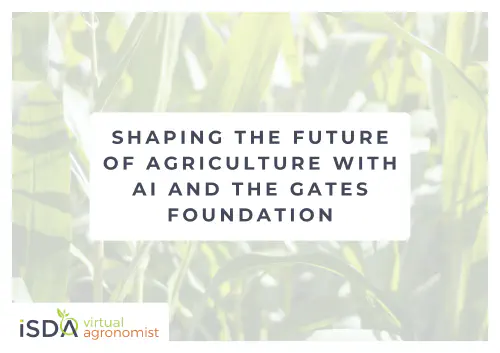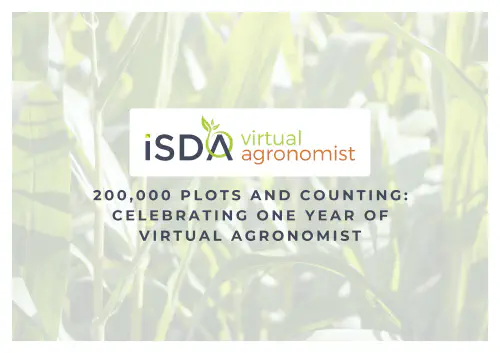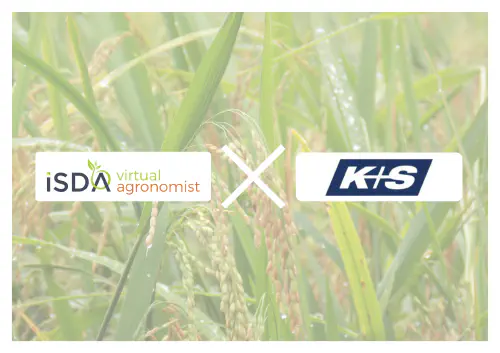Notes from the first African Conference on Precision Agriculture, 8th to 10th December 2020.
The session was hosted by Jonathan Crouch (CEO, iSDA) with contributions from Matt Miller (Lead Data Scientist, iSDA), Jamie Collinson (CTO, iSDA), and Keith Shepherd (Head of Diagnostics and Decision Science, iSDA). The Panel comprised Praveen Singh (Agronomist, Indorama), Pieter Pypers (Senior Agronomist, International Institute of Tropical Agriculture), and Rik van den Bosch (Director, International Soil Reference and Information Centre).
View the recorded videos from the conference.
iSDAsoil mission
The idea of creating a digital soil map of the world originated in a paper by Pedro A Sanchez (2017), available through the SoilGrids portal. Technological advances have allowed us to take this into the field. The aim is to engage with smallholders across Africa to raise their income. Building relationships with commercial enterprises in smallholder value chains, and harness the market forces to enable us to deliver interventions at high scale.
We are a social enterprise. Our core business is around data analytics and decision support tools. We aim to build and apply them within both the biological and economic contexts. Our primary key performance indicator is sustainable smallholder profitability, beyond productivity.
Applications of the tool
Soil properties maps along with nutrient omission trials are used to create tools for fertiliser recommendations for farmers. Pieter Pypers comments that once you have a certain number of trials on a particular crop, then you can rely on the data more heavily in the future. For different crops you may still need to run some trials, but not always in huge numbers.
Through integrating the risk and uncertainty of the data into advisory activities, you move towards optimising fertiliser recommendations. Which may not be that which produces the highest yield. Looking at the risk of loss and the variable attainable yield, a lower-level investment may actually be a better bet for the farmer, says Keith Shepherd.
Uncertainty and risk
Inclusion of the uncertainty layers sets iSDA apart from other tools. We have also built tools to simulate errors, continues Keith. The propagation of errors throughout a model can be analysed to see what the effect would be on profit for the farmer or farmers.
Rik van den Bosch reminds us that higher resolution is not by definition higher accuracy. It’s important for the users to check the uncertainty and to make up their mind if that uncertainty is low enough for their specific use.
For the current map, when validating the data used for the model, we did have minimal accuracy thresholds, says Matt Millar. Where the predictive models weren’t accurate enough to give useful data, we did not include it in our predictive soil mapping process.
Increasing profitability for farmers
The foundation for any crop productivity system is to efficiently utilise the resources, says Praveen Singh. The first step for crop management and nutrition is soil analysis information. Academics can use the information to develop policy and products, but a farmer can click on his farm or field and with the help of an agronomist, they can get the requirements for fertiliser and the use of the fertiliser. Inefficient use of the fertiliser can result in significant loss, up to 80% of the fertiliser applied.
Keith adds that the soil map gives the most value when the farmer is starting from a low yield level and little information on the soil. The soil map can therefore increase profits by $50-100 per hectare. The first step reduces the greatest amount of uncertainty, and later improvements to the soil map only incrementally improve on this.
Why is the data free?
A lot of the data that was the basis of iSDAsoil was created by grant-funded projects. So we felt that the best thing to do was to make this data easily accessible and readily useable. Even as a profit-seeking company, we see that as a potential business model where we can build on the foundations of publicly generated data. Together with others in the system we can build tailored solutions for smallholders
The future
Linking data to crop response
Pieter suggests that rather than the raw soil properties, creating a system that produces nutrient supply maps. A useful and relevant information layer that links raw data with crop performance. Which would be important for fertiliser advice.
Political perspective
It is important that we collaborate with national institutions, who have higher detailed data for their territories, comments Rik van den Bosch. There is also a political dimension to this.
“Policymakers at national levels are quite enthusiastic when talking about these products, but when asked if they would use them in policymaking and other activities they would always say ‘No’. They have invested in their own national institutions, so they prefer to use their own resources. Next steps, I would say let’s work with national institutes and build national-level products.” - Rik van den Bosch
iSDA will continue to collaborate with both national and commercial organisations to ensure both the high quality and usefulness of the data.
Time series nutrient and soil management mapping
Rik van den Bosch asks if in the future soil management information will be taken into account.
“Some samples have been taken a couple of weeks ago, others decades ago. The soil has changed over time due to the soil management by the farmers themselves through fertiliser use, manure, tillage, etc. So it would be nice to keep track of those changes over time.” - Rik van den Bosch
At the moment what we have is a static map of an average time period for approximately the last ten year, explains Matt. If we have repeat soil sampling from the same locations, and we also know the cropping history then we can start to build that into the soil maps. This becomes more feasible as we are able to access time series satellite data and direct information from the farmers as to their management of the land in the last couple of years.
Regional analysis and downloads
Currently we don’t have this functionality, says Matt Millar. You can query a specific location or download the whole dataset. We will be loading it into the Google Earth Engine, which will allow some level of arbitrary geographical query at a later date.
Collaborate with us
The current model is the building block upon which we can build more complex tools. What would really improve the accuracy are more ground truth points. More wet chemistry, more samples on the ground. We are looking for substantial new datasets, both developed ourselves and shared by others.
iSDA are collecting feedback from users. We review all requests about expansion of functionality and look at the importance of each request. We know that the community are going to come up with their own ideas, and we are happy to talk to people who want to co-develop or do anything with iSDAsoil. We see it as the bottom building block to a larger set of advisory tools and services.



